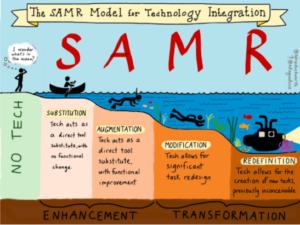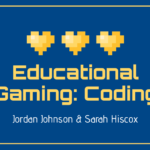Integrating technology into the classroom is not a necessity, but it has the ability to increase engagement, collaboration, and make teaching and learning more fun. Students can learn valuable skills through the use of technology–but how can we be deliberate and meaningful while using tech in our classrooms?
One approach to integrating technology into the classrooms is the SAMR model.
SAMR Model of Technology Integration
The Substitution, Augmentation, Modification, and Redefinition (SAMR) model is a four-level approach for selecting, using, and evaluating technology in K-12 settings.

Image Retrieved from https://sylviaduckworth.com/
No Tech-When no technology is used in the classroom.
Substitution-acts as a direct tool, with no functional change. An example of this is getting students to use Google Earth instead of a physical map.
Augmentation-acts as a direct tool substitute, with functional improvement. Example: using Google Earth to get students to measure the distance on a map, without the use of calipers or estimation.
Modification-when the technology significantly changes the design of the task. Example: create and scan a QR code.
Re-definition– when the tech allows for creation of new tasks (that would not be achievable without technology). Examples: Memes, graphics, multimedia (coding projects), getting students to collaborate on google docs (for quick feedback/and peer review).
When considering whether or not to integrate technology into the classroom, it is important to consider-how will technology expand and build upon students understanding? For myself, I appreciate when profs record videos explaining concepts and course material. That way I can refer back to the video as many times as needed. Another way in which technology has greatly improved my learning is through the use of Google docs. Having the ability to edit a shared doc, alongside my peers, while working on group projects has been essential during this past year of online learning.
Many parents and teachers have concerns regarding what media and technology they should introduce to their children/students and today I learned about an amazing site that addresses those concerns.
Common Sense Media
Common Sense Media is an independent website that researches, reviews and rates media that children are consuming. They provide in depth information on T.V. shows, movies, apps, resources, books and more to ensure that parents and educators can rest easy regarding the information that children are receiving online.
They divide their website for parents, educators, and advocates, as well as by different media sources. This is a great platform to inquire about the types of popular media that children are exposed to and also has very thorough tutorials on how to integrate tech into the lives of children; while teaching them about digital citizenship.
I will definitely be referring back to this website before I integrate specific technologies into the lives of my children and my students!
Plus: For educators they also have extremely useful learning activities divided by grade and subject through https://wideopenschool.org/.





